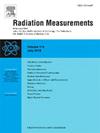评估海洋沉积物岩心中细粒沉积物的石英发光灵敏度方案
IF 2.2
3区 物理与天体物理
Q2 NUCLEAR SCIENCE & TECHNOLOGY
引用次数: 0
摘要
石英发光法在沉积物测年以外的应用正在迅速扩大。越来越多的研究成功地将石英光激发发光(OSL)和热释光(TL)灵敏度应用于沉积物物源调查和基于海洋沉积物岩心的古气候重建中,这些岩心通常由细粒度沉积物(粉砂和粘土)组成,需要对多矿物样品进行测量。然而,样品制备过程和测定细粒多矿物样品石英OSL和TL灵敏度的发光测量条件尚未得到广泛的评估。在这里,我们提出了五种不同测试的结果,旨在确定制备样品和测量其石英发光灵敏度时采用的当前程序是否可以改进和/或简化。测试包括评估石英OSL和TL灵敏度对以下因素的依赖性:(1)发光测量条件(即有预热和没有预热,在室温和125°C下进行光刺激,基于自然剂量和实验室剂量);(2)等分质量;(3)每个样本的等分数;(4)粒度选择;(5)长石含量。对分别从靠近Parnaíba河口和Orinoco河口的赤道大西洋西部回收的两个海洋岩心GeoB16206-1和M78/1-235-1的多矿物细沉积物进行了试验。总的来说,我们的结果表明,制备石英OSL或TL灵敏度测量的多矿物同质物的程序可以根据具体情况轻松优化,从而节省时间和资源。我们的关键结果是,使用自然信号和未经热处理(测试1)测量的石英OSL灵敏度与使用再生剂量和预热获得的结果非常相似。这开启了将OSL测量时间减少70%的可能性,并且可以使用便携式发光阅读器扫描海洋沉积物岩心,而无需使用辐射源进行信号再生。试验2和3表明,超过6个等分液或由0.4 mg至5 mg组成的等分液所给出的OSL和TL敏感性结果无法区分。在安装等分之前等待更长的沉淀时间来对更细的分数进行取样(测试4)有助于减少长石,但也可能显著减少石英,限制%BOSL1s分析。最后,包括蚀刻步骤以减少长石(测试5)是一个有助于提高TL和OSL灵敏度分析的过程,但对于数百个样品的常规应用并不一定可行。本文章由计算机程序翻译,如有差异,请以英文原文为准。
Assessing quartz luminescence sensitivity protocols for fine-grained sediments in marine sediment cores
Applications of quartz luminescence beyond sediment dating are expanding rapidly. A growing number of studies have successfully applied quartz optically stimulated luminescence (OSL) and thermoluminescence (TL) sensitivities in sediment provenance investigations and palaeoclimate reconstructions based on marine sediment cores, which are usually composed of fine-grained sediments (silt and clay), demanding measurements on polymineral samples. However, the procedures during sample preparation and the luminescence measurement conditions for determining the quartz OSL and TL sensitivities of fine-grained polymineral samples have not yet been extensively assessed. Here, we present the results of five different tests designed to determine whether the current procedures employed when preparing the samples and measuring their quartz luminescence sensitivities could be improved and/or simplified. The tests include assessing the dependency of quartz OSL and TL sensitivities on: (1) luminescence measurement conditions (i.e., with and without preheat, with light stimulation at room temperature and at 125 °C, based on natural and laboratory dose); (2) aliquot mass; (3) number of aliquots per sample; (4) grain size selection; and (5) feldspar content. Tests were performed on polymineral fine sediments from two marine cores, GeoB16206–1 and M78/1-235-1, recovered from the western equatorial Atlantic, close to the mouth of the Parnaíba and Orinoco rivers, respectively. In general, our results show that the procedures when preparing polymineral aliquots for quartz OSL or TL sensitivity measurements can be easily optimized on a case-by-case basis, saving time and resources. Our key result is that quartz OSL sensitivity obtained using natural signals and measured without thermal treatments (Test 1) are very similar to the results obtained using regenerative doses and preheating. This opens the possibility of reducing the OSL measurement time by 70 % and of scanning marine sediment cores with portable luminescence readers without the use of radiation sources for signal regeneration. Tests 2 and 3 show that both OSL and TL sensitivity results given by more than six aliquots or by aliquots made of 0.4 mg to 5 mg are indistinguishable. Waiting longer settling times to subsample finer fractions before mounting the aliquots (Test 4) is helpful to reduce feldspar, but it may also reduce the quartz significantly, limiting the %BOSL1s analysis. Finally, including an etching step to reduce feldspar (Test 5) is a helpful procedure to improve the TL and OSL sensitivity analysis, but not necessarily feasible for routine application with hundreds of samples.
求助全文
通过发布文献求助,成功后即可免费获取论文全文。
去求助
来源期刊

Radiation Measurements
工程技术-核科学技术
CiteScore
4.10
自引率
20.00%
发文量
116
审稿时长
48 days
期刊介绍:
The journal seeks to publish papers that present advances in the following areas: spontaneous and stimulated luminescence (including scintillating materials, thermoluminescence, and optically stimulated luminescence); electron spin resonance of natural and synthetic materials; the physics, design and performance of radiation measurements (including computational modelling such as electronic transport simulations); the novel basic aspects of radiation measurement in medical physics. Studies of energy-transfer phenomena, track physics and microdosimetry are also of interest to the journal.
Applications relevant to the journal, particularly where they present novel detection techniques, novel analytical approaches or novel materials, include: personal dosimetry (including dosimetric quantities, active/electronic and passive monitoring techniques for photon, neutron and charged-particle exposures); environmental dosimetry (including methodological advances and predictive models related to radon, but generally excluding local survey results of radon where the main aim is to establish the radiation risk to populations); cosmic and high-energy radiation measurements (including dosimetry, space radiation effects, and single event upsets); dosimetry-based archaeological and Quaternary dating; dosimetry-based approaches to thermochronometry; accident and retrospective dosimetry (including activation detectors), and dosimetry and measurements related to medical applications.
 求助内容:
求助内容: 应助结果提醒方式:
应助结果提醒方式:


